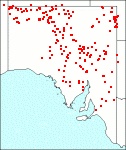Family: Campanulaceae
Wahlenbergia tumidifructa
Citation:
P.J. Smith, sp. nov.
Synonymy: Wahlenbergia gracilis, Wahlenbergia sp. B Common name: None
Description:
Perennial tufted herbs with a fleshy rootstock; typically upper parts glabrous, lower parts sparsely hirsute; stems 4-90 cm long, branching below the inflorescence; leaves alternate or sometimes the lowermost opposite, 2-60 mm long, 0.2-12 mm wide, obovate, becoming linear up the stem, margins flat or undulate.
Inflorescence a terminal cyme; receptacle 1-3 mm long, globular, cylindrical or sometimes obconical; sepals 5, 1-4 mm long, narrowly triangular, acute; corolla blue, sometimes pink or white, campanulate; tube 1-5 mm long, cylindrical; lobes 5, 2-7 mm long, less than twice as long as the tube, elliptical; stamens 5; filaments c. 1 mm long, rhombic with protuberant shoulders; anthers c. 2 mm long; ovary 3-celled; style 2.5-6 mm long, 3-fid, uncontracted or sometimes contracted about halfway down, with 1-3 glands below each stigmatic cleft and the uppermost often elongated.
Capsule 2.5-9 mm long, globular, cylindrical or sometimes obconical, typically rather swollen in appearance.

| Flower and fruit.
|
Image source: fig. 627j in Jessop J.P. & Toelken H.R. (Ed.) 1986. Flora of South Australia (4th edn).
|
|
|
Distribution:
|
A common species found in open sites in a variety of vegetation types.
S.Aust.: NW, LE, NU, GT, FR, EA, EP, MU. W.Aust.; N.T.; Qld; N.S.W.; Vic.
|
Conservation status:
native
Flowering time: throughout the year.
|

SA Distribution Map based
on current data relating to
specimens held in the
State Herbarium of South Australia
|
Biology:
No text
Taxonomic notes:
Holotype:. N.S.W., 85 km from Cobar on the road to Wilcannia, P.J. Smith 73, 4.xi. 1973 (NSW). Herbae caespitosae perennes caudice succulento, typice partibus superis glabrae et infernis sparsim hirsutae; caules 4-90 cm longi, ramosi infra inflorescentiam; folia alterna vel interdum infima opposita, 2-60 mm longa, 0.2-12 mm lata, obovata, lineariascentia secus caules, marginibus planis vel undulatis; inflorescentia cyma terminalis; receptaculum 1-3 mm longum, globulosum, cylindricum vel interdum obconicum; sepala 5, 1-4 mm longa, anguste triangularia, acuta; corolla caerulea, interdum rosea vel alba, campanulata, tubo 1-5 mm longo, cylindrico, lobis 5, 2-7 mm longis, brevioribus quam 2plo tubo, ellipticis; stamina 5, filis c. 1 mm longis, rhombeis cum humeris protuberantibus, antheris c. 4mm longis; ovarium 3-loculatum, stylo 2.5-6 mm longo, interdum contracto ad circiter medium, glandibus 1-3 infra fissuram stigmaticam et summis interdum elongatis; capsula 2.5-9 mm longa, globulosa, cylindrica vel interdum obconica, typice aspectu tumida. The epithet refers to the fruits, which are typically rather swollen in appearance.
Author:
Not yet available
|

